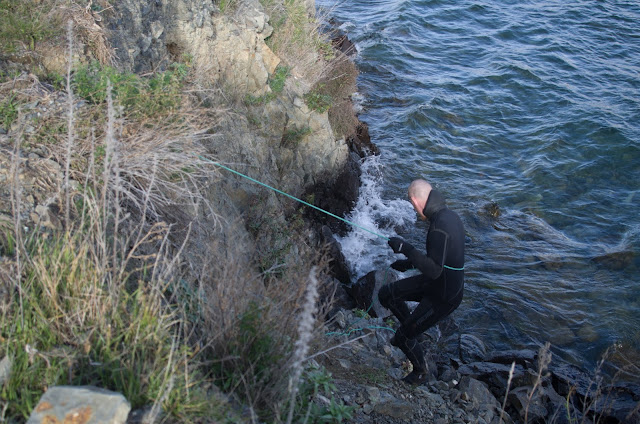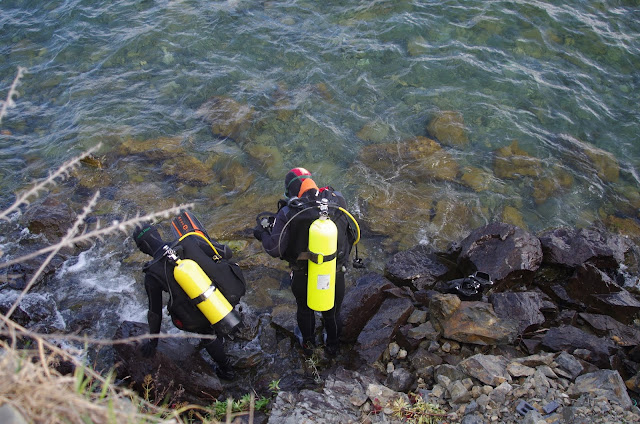So when it came to my birthday weekend this year it made sense to head up to Aviemore for a little bit more exploration. We had recently got our hands on a bathymetric chart of the lake showing us what depths we could expect throughout the main section of the lake. Armed with this knowledge we set off with two goals for the weekend. Firstly we wanted to do a dive on my birthday and secondly we wanted to explore one of the deeper sections of lake that we had identified on the chart.
The first goal was relatively easy to achieve. Well we thought it would be. We had planned to do a night drift dive along a section of lake known as the Aviemore river. This section sits just below the Benmore dam and is only 50-100m (160-330ft) wide and has a fair amount of current flowing through it. Our intention was to make our way to the lake after work and do our dive as soon as we got there. Unfortunately, one of us, who shall not be named, forgot a key piece of diving equipment and had to turn around and head back home to get it. This meant that we weren't both at the lake until around 11pm. No big deal a night dive is meant to be done in the dark anyway. So with both of us up at the lake we prepared our equipment in the garage and loaded everything into the car before donning our wetsuits and driving down to the lakes edge. One of the great things about drifting the Aviemore river is the ease of access. It's one of the only spots I know of that you can do a shore dive that's also a drift dive and guarantee that you'll exit in the right spot. This means we can drop off our gear at our entry point and then drive the car down to the exit point before walking the 20 or so minutes back to the entry point. We entered the water noticing that the lake level was a little lower than usual. I took the float and led the dive and all the worries of surface life disappeared. We had a plan to move a little further out from shore into deeper water than usual to explore some new areas of lake. This didn't seem to be paying off initially until we found something totally unexpected. We knew there was remnants of an old bridge in there somewhere but I had never seen it myself. This dive changed that. Out of nowhere an immense hunk of steel emerged from the darkness. This continued for a fair while as we swam over and around this structure that seemed out of place in an underwater environment. After the bridge it was more of what we were used to. A few trout and salmon swimming around but too easily spooked to be photographed. We then made it to the shallows that marked our exit point. We followed the slope up and exited the water. A massive sigh of relief was had when we saw the car parked only 50m away. Out of the water we headed back to the bach (Kiwi term for holiday home) and broke down the gear, rinsed the wetsuits and began our planning for the next day.
Dive profile for night drift
Approximate path followed
It's not a trip report without a fish photo right?
Saturday came around and it was time to get serious about finding the deeper spots of the lake. We had tried previously but hadn't quite found the right spot. This time we spent a lot longer looking over the chart and ensuring that we would have exact coordinates for our entry point. Luckily I could remember enough from my skippers ticket training to do a bit of chartwork and figure out some coordinates we could follow using the GPS on our phones. Given that these coordinates had to be converted between a number of different systems and that I had used pieces of paper instead of parallel rules I was dubious about how accurate they actually would be. Adam had faith in me so again we prepped the gear in the garage loaded up the car and made our way to the coordinates we thought were right. When we arrived everything matched up with what we expected so we began the final preparation for the dive. We had one minor obstacle to overcome before we could slip below the surface and enjoy the dive. Whilst there was ample room to park and prepare the gear next to the road the edge of the lake was about 3m below the road down a rocky cliff. No problem we're kiwi's and we can overcome this we thought. Adam found us a rope in the car which I tied off the tow bar of the car to enable me to abseil down the cliff to the waters edge. Once I was safely down the cliff Adam pulled the rope back up and we began the slow process of lowering the gear down piece by piece. I have to say I was a little bit concerned about Adam's knot tying abilities (he doesn't know this) but he well and truly proved he can tie knots that work. They're knot pretty but they work (sorry Adam!). Then it was Adam's turn to abseil down and we slipped into our gear, reviewed the plan, and disappeared below the surface.
Almost immediately we knew we in the right spot. A steep sloping bottom led us into the depths of the lake. At around 28-30m we encountered a flat section of bottom for 20m or so which then dropped steeply to our max depth of around 36m. We now believe that flat section was an old road or something similar from before the lake was flooded. At our max depth initially it seemed that whilst we had found the depth and location we wanted it was just going to be a silty bottom with nothing else to see. This soon changed as we swam a little further and out of the gloom emerged a forest of leafless Willow trees. This confirmed that we must have found the old riverbed which also meant we were likely to be the only people to see these trees since 1968. We explored swimming between the trees for a few more minutes before we reached our gas limits and turned to head for the surface. We had a pretty uneventful ascent, completed our safety stop, and surfaced a short surface swim from our exit point. We couldn't get out of the water quick enough, partly because it was rather cold but mainly because we were bursting with excitement. We'd been wanting to find this spot for a while and to have finally done it was an amazing feeling. Getting out of the water it was basically the reverse of getting in. Adam climbed first, I tied the gear to the rope and Adam hauled it up. Once all the gear was up I climbed up and we quickly removed our suits and made our way back to the bach.
Adam checks out the chart before the dive
Abseiling down the cliff
Adam lowers gear down
Gearing up on the edge of the lake
Entering the water
All ready to go
Such great spot to dive
Dive Profile
Area explored
Before we had made it back to the bach we were already planning our next trip to this same spot. We had chosen not to take cameras on this dive as we had very little idea of what to expect and wanted to enjoy the dive rather than taskloading ourselves. We will definitely be back at some point to film, photograph, and map what is down there. Since this trip I have been searching for old records of the area and have found a number of maps that show what the terrain was like before the lake was flooded. I am interested to see how these compare to what we actually experience down there.
Thanks to Adam for being a great buddy and Emma for the surface support and photos.












No comments:
Post a Comment